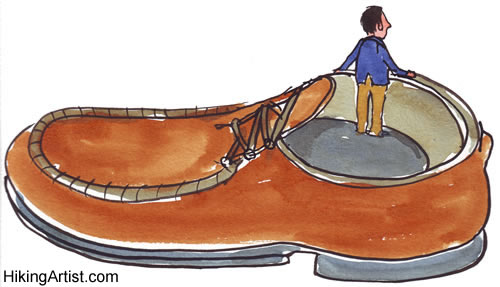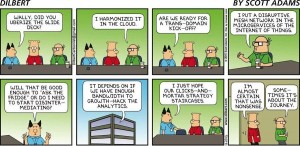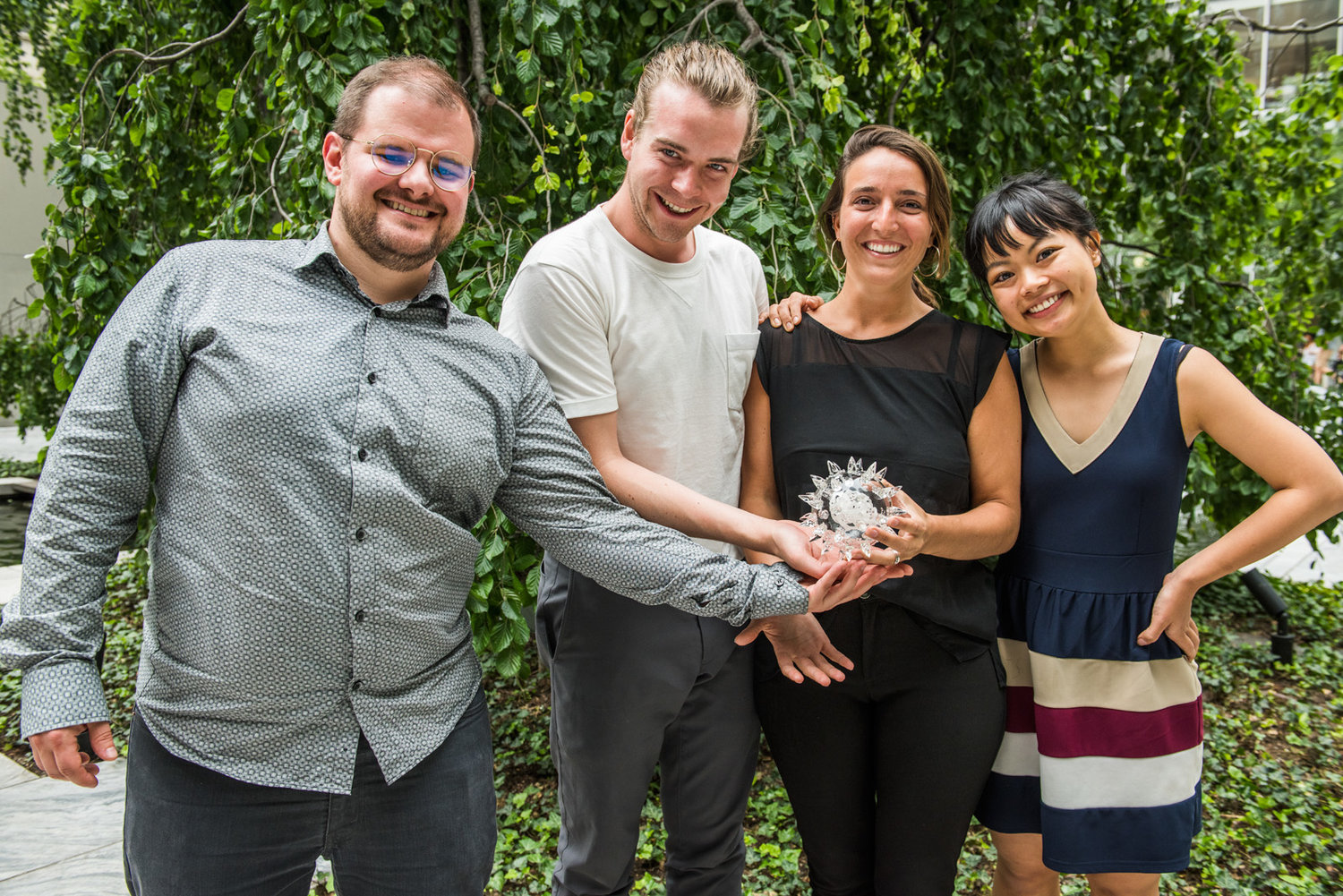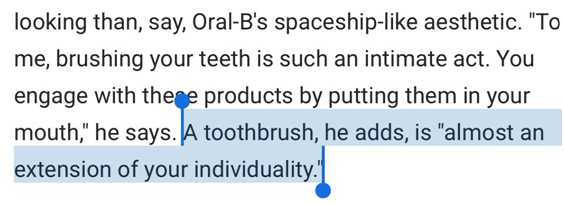|
|
|
Archive for the 'If the Shoe Fits' Category
Friday, September 14th, 2018

A Friday series exploring Startups and the people who make them go. Read all If the Shoe Fits posts here.
Early this year I wrote Convenience is Killing Creativity and today is a sort of follow-up to that post.
A few days ago another story popped up condemning tech’s fixation on “easy to use.”
These days, the gold standard for tech is whether or not it’s “easy to use.” (…) So easy a five-year-old could do it. That is a nice ideal.
But simplicity comes at a cost, and five-year-olds are not very smart. A simple tool is, by definition, inflexible. Software that boils everything down to one button needs to make a lot of assumptions about what the user is trying to do. If you don’t agree with those assumptions, too bad.
Too bad is right.
While the author was focused on software programs, assumptions are found everywhere.
I hate those assumptions. Windows 10 doesn’t like how I personalize my computer, so it just goes ahead and changes everything back to what some damn 25 year old thinks it should be.
And it’s not just software.
Surveys and questionnaires are terrible, especially those in healthcare.
Even multiple choice offers absolute choices, with little flexibility; how often have you seen ‘sometimes’?
The problem is that, for most of us, true answers are more nuanced.
Sure, sometimes the nuances and subtleties don’t really matter, but too often they make the difference between an accurate picture and one that is distorted, or, at the least, blurred by the creator’s bias (as opposed to one’s own).
Bottom line: tech dumbs us down with “ease of use” and everyone limits us with lack of choice.
Image credit: HikingArtist
Posted in Communication, If the Shoe Fits | No Comments »
Friday, September 7th, 2018

A Friday series exploring Startups and the people who make them go. Read all If the Shoe Fits posts here.
I love sandwiches.
My wife says I grew up in a “sandwich culture.” She grew up in the American South where people sat down to eat full meals a lot. We did that too in New York City, where I grew up, but sandwiches were a key part of life.
I’d stop by the deli on my way to my job after the school day was done and pick up the sandwich that would be my “dinner” that night. I rotated through roast beef and corned beef and pastrami. Cheese. Rye bread. I’d use some of my earnings to buy sandwich fixings for the weekend when I didn’t work. The best sandwiches were the ones you ate leaning over the sink.
Sometime in the last twenty years, sandwiches changed. The bread got flimsy and there was a lot less meat. People wanted to eat healthy so they cut back on the bread and the meat, but kept the cheese. Then came “low calorie” cheese.
Ugh. Low calorie cheese tastes like drywall. I kept my rye bread and I wanted a slab of cheddar or swiss on my roast beef, but I was the exception.
The sandwich in the age of the obesity epidemic
The challenge was pretty straightforward. As cheese became a more and more important part of the sandwich, people wanted it to taste good. Cheese makers responded by making low calorie cheese in various formulations. It tasted like drywall. They tried other formulas. It still tasted like drywall. Then the people at Sargento rethought the challenge.
Sargento: a history of innovation
Sargento is a big player in the packaged cheese business. They’re also a family owned company that’s been around since the 1950s with a history of innovation. In 1969, they introduced the pegbar system that’s now standard in supermarkets. They were the first to use re-sealable packages for cheese and the first to package shredded cheese.
Changing the challenge
The company figured that whatever they came up with would have to meet two criteria. It would have to use real cheese, not low-calorie, horrid tasting “cheese.” In other words, it would have to taste the way customers wanted cheese to taste. And, each slice would have to have no more than 45 calories.
Somebody at Sargento must have thought: “We can’t make low calorie cheese that tastes good. And we can’t offer smaller slices. What if we could reduce the calories in a slice of cheese by slicing real cheese thinner?”
The new challenge
That’s a great idea, but existing equipment couldn’t do it. Sargento could slice the cheese thinner, but then the slices would stick together. Whatever they came up with would have to work with existing packaging. Meeting that challenge took a $20 million investment in new technology. Sargento made it work.
The big payoff
Ultra-Thin Slices were released in 2012 and did $60 million in sales the first year. The second year sales more than doubled to $157 million. Even better, Ultra-Thin Slices attracted a lot of people who weren’t eating packaged cheese before. In other words, much of the sales growth was from new customers. That’s a breakthrough innovation by any standard.
What you can learn from Sargento’s Ultra-Thin Slices: rethinking the challenge
The breakthrough innovation didn’t happen until someone reconceived the challenge. Before, everyone, including Sargento, had conceived the challenge as coming up with a lower calorie cheese. When Sargento changed that to “slice cheese thinner so it’s only 45 calories” solutions became obvious.
What you can learn from Sargento’s Ultra-Thin Slices: the courage of conviction
It looks obvious now, but it took real courage to commit $20 million to develop new technology to support the reconception of the challenge. It may not have been a “bet the company” moment, but it was close.
Bottom Lines
Great innovation will not happen until you think of the challenge differently.
Making a great innovation a reality will not happen without courage.
Originally published at Three Star Leadership in 2016.
Image credit: HikingArtist
Posted in Entrepreneurs, If the Shoe Fits, Innovation | No Comments »
Friday, August 31st, 2018

A Friday series exploring Startups and the people who make them go. Read all If the Shoe Fits posts here.
Founders are a breed apart, especially young founders, with little to no business experience, let alone leadership/managerial experience.
I got a call from one I work with occasionally. After getting the information he had called for he took me to task over Monday’s post.
In short, he said that founders don’t have much time to spend on culture, let alone do the people-managing stuff I’m always writing about.
He went on to say that’s why people in young companies tend to be so similar. It’s far easier, not to mention more comfortable, to get stuff done when everyone has a similar mindset.
My response was that his mindset would do much to limit his market, so he would do well to plan on being a nitch player.
It was not appreciated.
Curating a team creates the same problem that curating freshmen roommate assignments created.
There’s no question that curation reinforces opinions, while eliminating conflicting ones, narrows people beyond from where they started and acts like fertilizer to unconscious bias and outright bigotry.
Curation, whether of roommates of team, has no positive effect, which is why colleges are going back to random freshman matching and companies are striving for more diversity. Duke eliminated curated matching.
Freshman year of college, Larry Moneta, vice president for student affairs at Duke explained, is about students “engaging with difference and opening their eyes to opportunities, and meeting entirely different people than the ones they grew up with or went to high school with.”
What this 26-year-old founder didn’t say (and may not even realize) is that some things, such as successful managing, are the result of hard-won experience, not “vision.”
There is a reason that more diverse companies have better results.
Just as there is a reason that managers who practice good customer service on their teams attract the best people, have lower turnover, and enjoy better personal career growth / stronger startup success (if founders).
Image credit: HikingArtist
Posted in Culture, Entrepreneurs, If the Shoe Fits, Personal Growth | No Comments »
Friday, August 17th, 2018

Mega rounds of funding are creating a frenzy in the startup world.
Start-ups raising $100 million or more from investors — known as a mega-round in Silicon Valley — used to be a rarity. But now, they are practically routine, producing a frenzy around tech companies with enough scale and momentum to absorb a large check.
But are they smart?
It may be great for ego and bragging rights, but does it make you richer?
Probably not.
Consider Zappos and Wayfair.
EACH ONE of Wayfair’s two co-founders made as much money as ALL of Zappos’ shareholders combined. (…) Put another way, Wayfair co-founders made at nearly 10X as much as Hsieh.
Mega rounds hurt employees by substantially diluting their stock and forces you to grow, often at an unreasonable rate.
In these days of frenzied money, some founders, such as Gusto’s founder/CEO Joshua Reeves choose to say no to excessive funding.
Gusto, a payroll and benefits software company, raised $140 million in July, but could have done five times that, according to Joshua Reeves, its chief executive and founder.
Startups seem to have forgotten that the purpose of a company is to make money, not raise it.
Mr. Reeves, of software start-up Gusto, acknowledged that founders who obtain outsize sums of capital can get caught up in a “growth at any cost” mentality. That is why he chose not to maximize his funding round despite the intense interest. “It’s up to the founder to realize that’s a distraction,” he said. “Success is not having more money or a bigger team, but having more customers or revenue.”
Think about it.
Image credit: HikingArtist
Posted in Culture, Entrepreneurs, If the Shoe Fits | No Comments »
Friday, August 10th, 2018

A Friday series exploring Startups and the people who make them go. Read all If the Shoe Fits posts here.
If you were sitting in Starbucks and heard the following from a man and a woman you couldn’t see, what would your reaction be?
If we can get every business in the world to adopt a global problem, get slightly smaller businesses to adopt a national problem, get smaller businesses still to adopt local problems, then we can get on top of pretty well every problem in the world.
Snicker at their naiveté? Wonder how they would monetize the idea? Drool a bit over the enormous trove of data they would have? Maybe give some thought on how you could get into the action?
Not that you would admit those thoughts in public.
But in the end, you would probably just shrug and write them off as a couple of idealistic dreamers who were unlikely to get anywhere with ideas like that.
Why?
Because they didn’t sound as if they had the passion, the drive, the pure grit, to pull off a truly world-changing idea.
All these scenarios are predicated on the assumption that the people talking were just people.
Would the fact that you were eavesdropping on Richard Branson and his daughter, Holly, cause you to change your assumptions?
Probably.
(Click to read more about Branson.)
Image credit: HikingArtist
Posted in If the Shoe Fits, Leadership, Personal Growth | No Comments »
Friday, August 3rd, 2018

A Friday series exploring Startups and the people who make them go. Read all If the Shoe Fits posts here.
Have you ever wondered where all the bullshit business terms (BBT) came/come from, especially since their spread predates the Net and social media by decades?
A fascinating article in the Guardian traces the birth and rise of business bullshit that sprang from a 20th-century Russian mystic, was embraced by corporate leaders, inspired Scott Adams of Dilbert fame, and has been re-imagined and added to by consultants and pundits ever since.
It hasn’t always been this way. A certain amount of empty talk is unavoidable when humans gather together in large groups, but the kind of bullshit through which we all have to wade every day is a remarkably recent creation.
Founders and others in tech are especially fond of BBT as they go about changing the world.
There’s even an online generator that takes the effort out of remembering terms yourself.
Business bullshit always reminds me of a guy I worked with, who believed the more multi-syllabic words he used the smarter he would sound.
He didn’t and you won’t either.
The article is long, but well worth the reading time.
It might even help squelch your own penchant for using them.
Hat tip to CB Insights for pointing me to the article.
Image credit: Scott Adams
Posted in Communication, If the Shoe Fits, Personal Growth | No Comments »
Friday, July 13th, 2018

A Friday series exploring Startups and the people who make them go. Read all If the Shoe Fits posts here.
Invent: Create or design (something that has not existed before); be the originator of.
Inovate: Make changes in something established, especially by introducing new methods, ideas, or products.
If you look carefully there is very little actual invention going on these days, it’s mostly innovation, based on previous products.
However, sometimes innovation is radical enough that it should count as invention.
Consider the lowly toilet.
The Gates Foundation has been funding the effort to reinvent the toilet.
In 2011, the Gates Foundation launched the Reinvent the Toilet Challenge to bring sustainable sanitation and hygiene solutions to the 2.5 billion people worldwide who do not have such access. The challenge, which is ongoing, is a global call to researchers around the world to develop innovative and financially profitable systems to manage human waste. The systems must operate off-grid, cost less than $.05 per day, and function in poor, urban settings.
Even corporate giants got into the effort.
Kohler—a leading U.S. manufacturer of toilets (…) received a Gates grant in 2014, describes these toilets as “stand-alone units that take in wastewater, then disinfect and purify it to be reused for toilet flushing.”
But water is also a scarce commodity, even when it’s reused.
Now, from a group of students at the University of British Columbia, comes the MYCOmmunity Toilet.
The MYCOmmunity Toilet consists of a mycelium tank that is small enough to sit inside each individual dwelling. (…) when it’s full, the toilet is buried in the ground or left somewhere out of the way for another 30 days to allow the composting process–aided by the mushroom spores–to finish. Each toilet includes local seeds, which can be planted on top of the toilet, allowing plants or crops to grow from the human waste.
Although it was designed specifically with refugee camps in mind, it would seem to have far greater potential.
The MYCOmmunity Toilet qualifies as an invention — with the potential to truly change the world.
Image credit: 2018 Biodesign Challenge
Posted in Entrepreneurs, If the Shoe Fits, Innovation, Role Models | No Comments »
Friday, June 8th, 2018

A Friday series exploring Startups and the people who make them go. Read all If the Shoe Fits posts here.
Did you read Ryan’s Journal yesterday? One of the things he talks about it the importance of starting with ‘why’, instead of just rushing in.
I get it, ‘because I’ve always been a ‘why’ person.
Founders would do well to ask ‘why’ more often, as in “Why are we building/doing this?”
The importance of that particular ‘why’ is data-driven, which is important, since the tech world especially believes that everything important is data driven.
I can cite dozens of sources, but I’ll use data from CB Insights, since it’s a startup and it’s product is data.
Tackling problems that are interesting to solve rather than those that serve a market need was cited as the No. 1 reason for failure, noted in 42% of cases. Or, as Treehouse Logic said, “We had great technology, great data on shopping behavior, great reputation as a thought leader, great expertise, great advisors, etc, but what we didn’t have was technology or business model that solved a pain point in a scalable way.”
A lot of people don’t like asking ‘why’, because, more than most, it is an uncomfortable question.
It usually requires introspection and frequently doesn’t return the desired answer.
Founders don’t like the why question for the same reasons, especially when it interferes with their beloved vision, let alone their worldview.
There are two ways of internalizing that data.
The obvious: Not asking ‘why’ increases my chance of failing by 42%.
The less obvious: Asking ‘why’ increases my chances of succeeding 42%.
If you subscribe to the less obvious approach, or want to, the simplest was to implement it is to embrace the Lean Startup methodology
Doing so may mean abandoning your initial vision, or, at the least, tweaking it, which could bruise your ego, but the payoff is huge.
And the bruising should be easier to handle knowing that you got a 42% boost on the road to success.
Image credit: HikingArtist
Posted in Culture, Entrepreneurs, If the Shoe Fits | No Comments »
Friday, May 18th, 2018

A Friday series exploring Startups and the people who make them go. Read all If the Shoe Fits posts here.
As you all know, startups are 80+ hour weeks and pre-launch adds at least 10 hours.
However, I wanted to share John Buchan’s words (he was an historian and Canadian politician), because it’s the kind of thing that can easily fall through the cracks when you’re living with intense startup pressure.
But it shouldn’t.
The task of leadership is not to put greatness into humanity, but to elicit it, for the greatness is already there.
It’s what we, as founders, owe to those who dare to take the trip with us.
Image credit: HikingArtist
Posted in Culture, Entrepreneurs, If the Shoe Fits, Leadership | No Comments »
Friday, May 11th, 2018

A Friday series exploring Startups and the people who make them go. Read all If the Shoe Fits posts here.
As I keep saying, I do love CB Insights daily newsletter. It provides me with needed information, but my love stems from Anand Sanwal’s quirky, irreverent, incisive comments, like this one.
I now see toothbrushes in a whole new light after this comment by the founder of a subscription-as-a-service toothbrush company.

Does this guy actually believe that something (AKA a toothbrush) that has no wheels, software or circuits can substitute as an “extension of personality?”
The only “change the world” ethos I can find here is greed coupled with the ability to sucker people who are either too lazy, too incompetent or too busy on social media to take care of their basic necessities.
Good grief, is this the best the vaunted Silicon Valley innovation machine can produce?
Image credit: HikingArtist
Posted in Entrepreneurs, If the Shoe Fits, Innovation | No Comments »
|
 Subscribe to
Subscribe to
MAPping Company Success
About Miki 
Clarify your exec summary, website, etc.
Have a quick question or just want to chat? Feel free to write or call me at 360.335.8054
The 12 Ingredients of a Fillable Req
CheatSheet for InterviewERS
CheatSheet for InterviewEEs™
Give your mind a rest. Here are 4 quick ways to get rid of kinks, break a logjam or juice your creativity!
Creative mousing
Bubblewrap!
Animal innovation
Brain teaser
The latest disaster is here at home; donate to the East Coast recovery efforts now!
Text REDCROSS to 90999 to make a $10 donation or call 00.733.2767. $10 really really does make a difference and you'll never miss it.
And always donate what you can whenever you can
The following accept cash and in-kind donations: Doctors Without Borders, UNICEF, Red Cross, World Food Program, Save the Children
*/
?>About Miki
About KG
Clarify your exec summary, website, marketing collateral, etc.
Have a question or just want to chat @ no cost? Feel free to write
Download useful assistance now.
Entrepreneurs face difficulties that are hard for most people to imagine, let alone understand. You can find anonymous help and connections that do understand at 7 cups of tea.
Crises never end.
$10 really does make a difference and you’ll never miss it,
while $10 a month has exponential power.
Always donate what you can whenever you can.
The following accept cash and in-kind donations:
|










